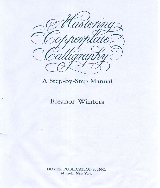

You can even practice the Copperplate strokes with a pencil if it all seems to be too much at the moment. REMEMBER: Don’t get overwhelmed! If you get really anxious, go back to the last step you were comfortable with and practice that. Like the #7, it’s an exit stroke to the next letter. #9: start counterclockwise to create a tiny filled oval, then exit. The 35-degree slant lines are there as guides for the angle of writing, not for spacing.ħ. If the x-height (base to waist space) is considered 2 units of space, then the ascender & descender lengths are 3 units of space. 3:2:3 at the bottom of the guideline sheet refers to the ratio of the spaces between the horizontal lines. The line above the waist is the ascender, the line below the base is the descender. These lines are indicated by the black box on the left margin. ¼-inch refers to the x-height, the space between the waist and the base. Guideline sheet: We’ll be starting with the large ¼ - inch guideline sheet. Place the guideline sheet underneath the first sheet. Fold this back so that you’ll have a flat writing surface without the cover bunching up to the left.

Preparing the paper: Make a crease in the cover of the cotton comp paper pad about an inch down from the top. NOTE: Vermillion ink will rust your nib, so wash it off with water after you’re done practicing. New nibs usually have a waxy coating and you may have to rub with gum Arabic several times until the ink will stay in the reservoir. If you have a brand new nib, you’ll need to prepare it by rubbing gum Arabic all around so that the ink will adhere to the nib and not just bead-up and slide off. Hold the oblique holder as you would normally hold your pen, with the angled nib to the left side. The fit may feel tight, but push the nib in at least halfway for a secure hold. Preparing the Pen: Put the nib into the oblique pen holder so that the “eye of the needle” (the opening in the nib) points directly upward. By the end of this semester, you will have filled out your nib chart with notes on each of the nibs, paying particular attention to each nib’s sharpness and flexibility. This is another important area to explore & learn. 5mm, 1mm), Copperplate nibs come in a wide variety of sharpness and flexibility. So unlike chisel-point nibs that come in different set widths (e.g. The more pressure you apply when pressing on a down stroke, the wider the stroke. Learn Your Nibs: Unlike calligraphy written with a chisel-point nib, Copperplate nibs create thicks & thins by pressing & releasing.


 0 kommentar(er)
0 kommentar(er)
